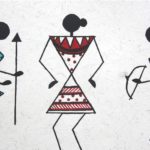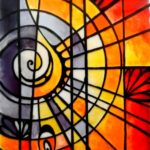One of the oldest forms of artwork found in Orissa, Patachitra art is fascinating, depicts Hindu mythological tales and wonders. Primarily based on these stories from the past, Patachitra art is vibrant, unique and is a fine display of dexterous Indian craftsmanship at its best.
This kind of artwork has a traditional appeal and is intrinsic to Indian values, customs and rituals, which are a part and parcel of the Hindu faith and religion. What started off as different forms of paintings has however evolved to become an immense facet of Indian accessories and other forms of traditional fashion as well.

Patachitra art
This form of artwork was first conceptualized in Orissa and dates back to the 5th century. According to historical evidence, the first forms of Patachitra art originated in the village of ‘Puri, where this artwork is still quite popular. The artists who practiced this craft were known as Mohapatra’s or Maharanas, although no clear distinction was given between the two. The astounding temples and architecture in Orissa are what lent its inspiration to all these creative craftsmen who narrated pictorial stories through their paintings and detailed work.
The patachitra of Orissa are icon paintings that include the wall paintings, manuscript painting, palm-leaf etching, and painting on cloth, both cotton, and silk. Chitrakar painters in and around Puri practice this living art form. The village of Raghurajpur is where many chitrakars live in an area dedicated to them called Chitrakar Sahe. This art of painting on cloth can be traced back to the establishment of the shrine of Lord Jagannath at Puri in Orissa.

The patachitra painting on a cardboard
The patachitra when painted on cloth follows a traditional process of preparation of the canvas. First, the base is prepared by coating the cloth with the soft, white, stone powder of chalk and a glue made from tamarind seeds. This gives the cloth tensile strength and a smooth, semi-absorbent surface, allowing it to accept the paint. The artist does not use a pencil or charcoal for the preliminary drawings. It is a tradition to complete the borders of the painting first.
The painter then starts making a rough sketch directly with the brush using light red and yellow. The main flat colours are applied next”;” the colours used are normally white, red, yellow, and black. The painter then finishes the painting with fine strokes of black brush lines, giving the effect of pen work. When the painting is completed it is held over a charcoal fire and lacquer is applied to the surface. This makes the painting water resistant and durable, besides giving it a shiny finish.

Gods of Jagannath
The materials used in the paint are from vegetable, earth, and mineral sources. Black is made out of lampblack, yellow from haritali stone, and red from hingal stone. White is prepared from crushed, boiled, and filtered shells. The subject matter of the pattachitra includes religious, mythological, and folk themes. Krishna leela and Lord Jagannath are important motifs.
Patachitra style of painting is a unique blend of classical and folk element but is more bent towards a folk style in the larger sense. What is even more interesting is that this artwork has Mughal influences as well when it comes to the character’s apparel and fashion sense. Features of each character are defined with clear dark lines which give a definite shape and appeal. Natural dyes and colors are used, all of which are derived from fruits and vegetables.

A patachitra art necklace
The background or landscape of each narrative is simple and not too detailed since the main focus lies on the characters and their actions. Flower and leaf motifs are the common styling elements used to give a more aesthetic appeal to the artwork. Traditional colors such as red, green, yellow, dark blue, white, and orange are used to define each section of the painting.
The one common element found in all patachitra art is the use of detailed borders which may or may not be in relation to the rest of the painting since they are used to give uniformity to the entire painting. The craftsman usually uses Cotton for this artwork, and apart from paint, no additional embellishments are used. The patachitra artists also paint their themes on wooden boxes, on bowls, on tussar silk, on outer shells of the coconut, and on wooden doors.
They are also working on producing painted wooden toys based on animals and birds portrayed in the paintings. The English alphabet is cut in the wood and painted in the pattachitra style for sale. The artists have also traditionally painted playing cards or Ganjifa.
Patachitra paintings traditionally drawn by the mahapatra’s or maharanas, the original artiste caste in Orissa. These paintings became an important art form with the ornamentation of Lord Jagannath in the innermost sanctum, where paintings on especially treated cloth or pata of the deities were done by the temple painter.
The themes were tribal and folk. Apart from paintings, pattachitra artwork is also widely used on Cotton, Silk and Georgette sarees. Quirky, unique and a refreshing appeal from the traditional saris, patachitra artwork lends a different sense of ethnic fashion to the 9-yard apparel. Bright hues such as red, pink, purple, yellow, green and white are used to adorn classic saris which add a vibrant twist to the epic tales that are narrated on the sari pallus or borders.
Apart from saris, patachitra art has become rampant with household accessories as well which includes ceramic bowls, pens, coasters, plates, wall hangings, key chains, and boxes as well. Currently, several designers and craftsman have come up with quirky ways of introducing this artwork on large handbags and totes, t-shirts, skirts, jeans, belts and even on stationary!



Wall Painting Contractors in Dubai
March 29, 2018Wonderful information, thanks a lot for sharing kind of information. Your website gives the best and the most interesting information. Thanks a ton once again, Regards, Wall Painting Contractors in Dubai
Wall Painting Contractors in Dubai
April 2, 2018Superb article and I would really like to thank for your article it’s really helpful. Regards Wall Painting Contractors in Dubai